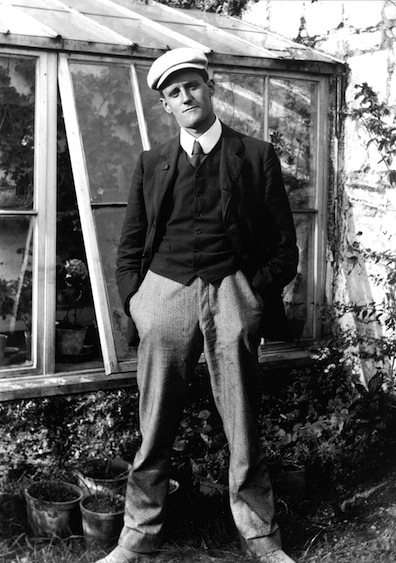In his list of creditors in Nestor Stephen recalls
that he owes "Curran" a quite large sum: "ten guineas."
Constantine Curran, "Con" or "Conn" to his friends, was a
friend to Joyce from their university days until the end of
Joyce's life. Of the ten college-age acquaintances in the
list, he is one of seven represented under their own names.
The other three––Mulligan, McCann, and Temple––are fictive
names for actual acquaintances.
Curran was born in Dublin on 30 January 1883, nearly one year
later than Joyce. The two met at University College, Dublin in
1899. Curran received a B.A. degree from the institution in
1902 and an M.A. in 1906. He studied law and was admitted to
the bar, but he never practiced. Instead he took a job in the
Accountant General's office of the Four Courts, and in 1946 he
became Registrar of the Supreme Court. He also studied
Dublin's architecture, particularly its plasterwork, and
published three books on those topics in 1945, 1953, and 1967.
He married actress, costume designer, and political activist
Helen Laird in 1913, and the two held celebrated cultural
salons on Wednesday afternoons at their home on Garville
Avenue.
In 1904 Curran was living at his parents' house just off the
North Circular Road, near the Christian Brothers
school on North Richmond Street.
It was in the garden of that house that he took a famous
photograph of Joyce standing with his hands in his pants
pockets, a yachting cap on his head. Asked what he was
thinking when Curran posed him, Joyce replied, "I was
wondering would he lend me five shillings." Curran did lend
him money on many occasions.
Ellmann writes of this "goodhearted" man that Joyce "in the
course of his lifetime was to owe Curran a great many
kindnesses" (63). In 1904, "Thanks to C. P. Curran, he was
able to pay something down at Piggott's and had a grand piano
delivered" (151). In the same year "Curran made him several
small loans with uncomplaining generosity" (162). After
calling The Holy Office "an unholy thing," Curran
"mollified him with a little money" (165). In 1905 Joyce wrote
to Stanislaus about the birth of his son "and asked him to
borrow a pound from Curran to help pay expenses" (204). In
1912, when he was desperately urging George Roberts to publish
Dubliners after three years of delays, "Curran proved
friendly and willing to speak to Roberts on his behalf" (329).
Gordon Bowker, in his "New Biography," glances at Curran's
many loans to Joyce, as in the following sentence: "Now that
the 'harshness of his situation' was revealed, Joyce invited
himself to Curran's office (he worked for the Accountant
General) hinting that he was 'in a bloody hole', and ready as
ever to take a loan if offered" (124). But he devotes more
attention to the kindnesses that Curran did Joyce later in
life, including the assistance that he provided to Lucia. When
Joyce died, Curran published an obituary in the Irish
Times showing that his devotion proceeded not only from
Christian kindness but also from a clearheaded assessment of
Joyce's genius: "His later life belongs to world literature,
where his influence has been as widespread, as profound and as
disruptive as that of Picasso in painting. He was as great a
master of English prose as Yeats was of English verse—that is
to say, he was one of the two greatest figures in contemporary
English literature" (535).
In 1968 this goodnatured and intelligent man published a
memoir of his lifelong friend titled James Joyce
Remembered. A new edition of the book, with scholarly
apparatus and many illustrations, is being released this year
by the University College Dublin Press and the University of
Chicago Press.


